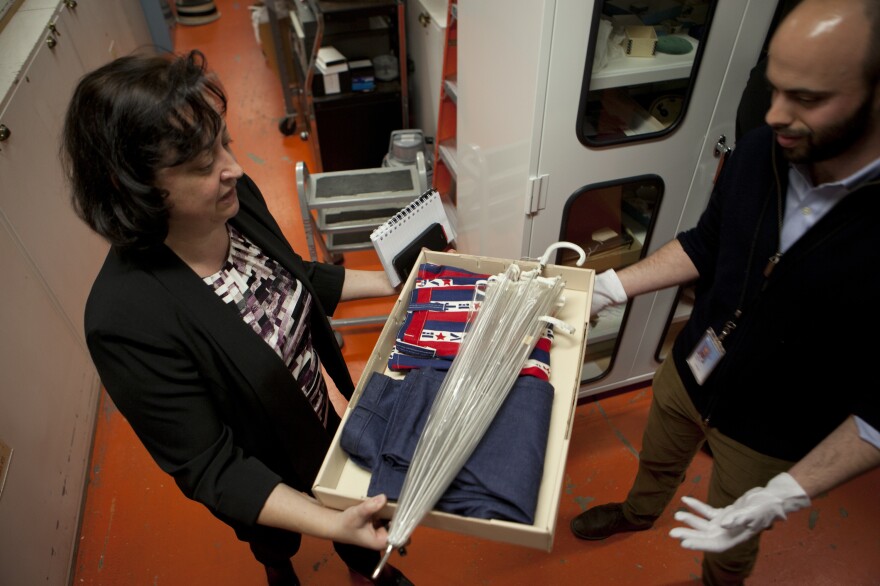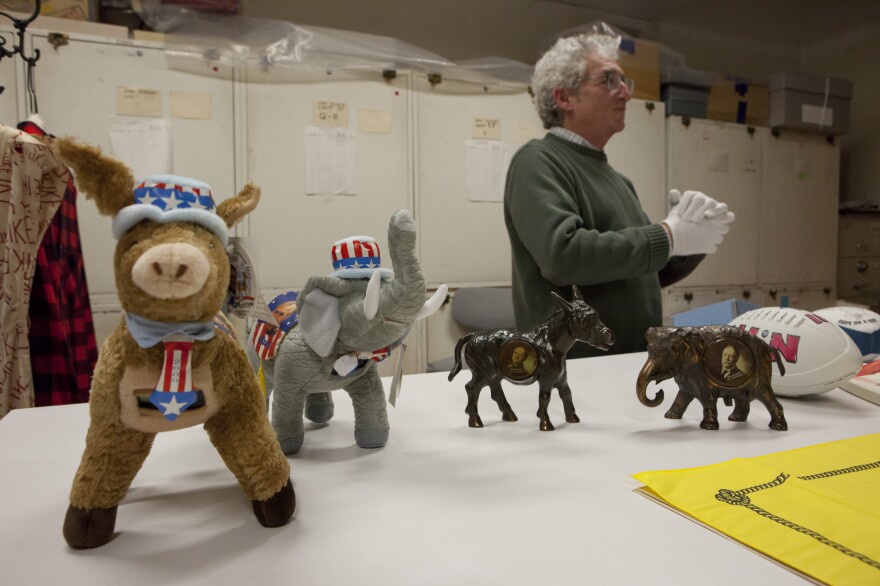Harry Rubenstein is deep in a thought about a log cabin when he pauses, mid-sentence, and disappears down a corridor.
He returns a moment later brandishing a large wooden ax.
Rubenstein is the chair of the political history division at the Smithsonian Museum of American History, and he's standing in a room that's packed with about 100,000 items from previous presidential elections. The collection, he says, ranges "from a little bit before the American Revolution, to probably last week."
From his vantage point in this locked, windowless room in the Smithsonian, Rubenstein is able to draw parallels between signs, hats and other tchotchkes crafted decades — even centuries — apart.

The cabin? It's from the original 1840 "log cabin campaign" — an attempt by William Henry Harrison's supporters to paint their candidate as a regular American with humble beginnings. "This is really the beginning of trying to create some sort of simple identity for candidates," Rubenstein says.
That's why he goes and grabs the ax. It's from another, more consequential election 20 years later, when the newly formed Republican Party was pushing a common-man narrative, as well. Its candidate: the "rail-splitter," Abe Lincoln.
"Fear not," the ax reads. "Old Abe is ours."
"This has become a real staple of campaigning, and you can see that being played out in contemporary campaigns today," Rubenstein says. Candidates may no longer grow up in log cabins or split firewood, but Republican presidential hopefuls like Marco Rubio and Ted Cruz talk up their parents' immigrant roots, and Hillary Clinton reminds voters of the struggles her mother went through growing up in a neglected household.
Today's Tchotchkes, Tomorrow's Exhibits
That continuity is why Rubenstein is preparing to send a team of curators to Iowa and New Hampshire over the next couple of weeks. They'll scour the early primary and caucus states for artifacts that help tell the story of the 2016 campaign to future generations, and then bring them back to the museum.
This year's memorabilia will join an impressive collection.
On a table in the room, there are jacket buttons commemorating George Washington's inauguration. A cast-iron elephant featuring a picture of William Howard Taft. From more recent campaigns, there are John Kerry flip-flops Republicans used to taunt the 2004 Democratic nominee, as well as "Deanie Babies" boosting Howard Dean.

That's right. Today's "Make America Great Again" hat could be tomorrow's rail-splitter ax.
Curators Lisa-Kathleen Graddy and Jon Grinspan will visit campaign headquarters and attend rallies. Later this year, they'll hunt for artifacts at party conventions. "We know that we're going to try and get the standard materials that each campaign is putting out," Graddy says. "The signs, posters, the bumper strickers, the buttons."
We're the most brazen people on earth...'I love that shirt you're wearing....I don't suppose you'd want to give it to me, would you?'
They'll also be looking for homemade items that supporters bring with them. "We're the most brazen people on earth," says Graddy. "Hi, I'm Lisa-Kathleen. I'm with the Smithsonian Institution. I love that shirt you're wearing. Can you tell me why you have it? I don't suppose you'd want to give it to me, would you?"
She says that on that last question, the answer is usually a no — at least right there in the moment. "If it's something that's meaningful to you right now, you might not want to give it to us right in the moment. Because one, you're still using it. I'm still at this rally. I still have this sign. I still have my shirt on."
"We distribute a lot of business cards," she adds.
228 Years Of History ... And Continuity
But as more and more of the political process shifts to the digital space, the Smithsonian has made a decision not to curate the images, memes and hashtags that increasingly define the campaign conversation. "This is a debate, and I'm sure that our future curators might curse some of us of the past" for not doing so, concedes Rubenstein.

But, he argues, the Smithsonian is seeing other institutions create that digital archive, "and so we decided we would focus, in a sense, on our strength, which are strange pins and funny hats and signs of all shapes and forms."
"These are the things that make you know that history's real," says Graddy. "It happened. We touched it. We used it. We wore it. These are the things that memories are really made of."
And those items, all together, also tell the story of American politics. For all the changes that have happened since the country first elected a president, Rubenstein says he's struck by how much remains the same.
The form itself may shift — a brass elephant from 1912 morphs into a plush George W. Bush elephant in 2000 — but, he says, the main idea remains the same. "It gets embellished and changed but the continuity is still there."

So far, 2016 has stood out as an especially angry election. I ask if there's anything in the collection that typifies the personal vitriol of some of America's early elections.
Graddy smiles.
"Should we show them the banner?" she asks.
Rubenstein disappears, and comes back with a large portfolio-type folder. He clears some space and unveils a banner from Thomas Jefferson's 1801 inauguration. Jefferson's victory against incumbent President John Adams was a nail-biter that was so close it served as one of the first tests of the country's new Constitution.
Jefferson supporters have drawn an image of their candidate. Next to it, an eagle holds a sign proclaiming Jefferson as the new president.
Its second line, however, reads: "John Adams is no more."
As Graddy puts it, "gloating is also an American tradition."
Copyright 2020 NPR. To see more, visit https://www.npr.org. 9(MDAxMzY2MjQ0MDEyMzcyMDQ5MzBhZWU5NA001))




